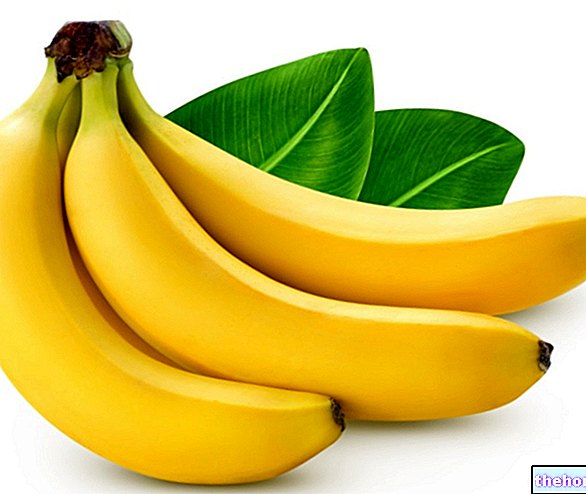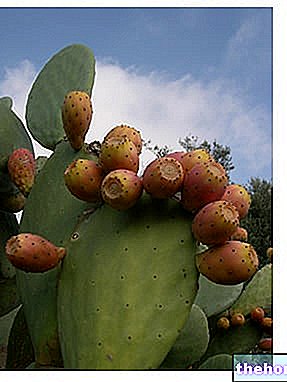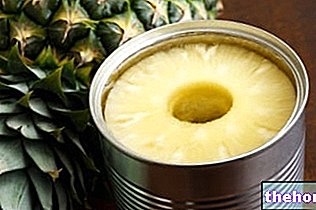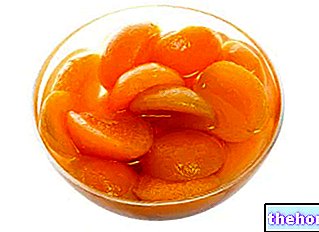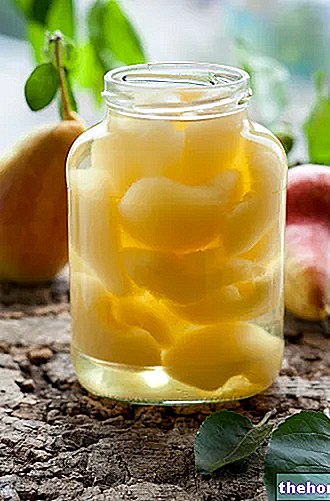Generality
Pears are the fruit, or rather the false fruit, of such trees Pyrus, belonging to the family of Rosaceae (subfamily Pomoidee), spontaneous in the humid - temperate climate zones of Europe and Asia.

The best known pears belong to the species Pyrus communis and they reach maturity starting from the end of July; after harvesting, the pears can be stored for a long time by using the cold in a controlled atmosphere, increasing the percentage of nitrogen in the air and eliminating as much as possible the "ethylene responsible for the progress of ripening; alternatively, they can undergo the typical industrial processes of preserved fruit.
The varieties of pears most marketed in our country and in Europe are: William pears, Max Red Bartlet pears, Decana pears, Abate Fétel pears, Kaiser pears, Conference pears, Spinella pears, Nashi pears, thigh pears, ercolina pears, cocomerina pears, pears from Emilia-Romagna, Mantovana pears, noble pears and Crassana pears.
Nutritional characteristics
Pears are false fruits (like apple and medlar); from the botanical point of view, in fact, the real fruit is constituted by the core, while the edible portion is the fleshy receptacle covered by the fibrous peel.
Pear fiber: fresh pears fall into the category of foods that can be defined as "raw", unprocessed, meaning that they can be eaten whole and possibly raw. Habitually, many people use to peel pears but - ignoring for a moment the fear that the pesticide treatments of conventional agriculture may remain on or inside the fruit - from a strictly dietary point of view it is an absolutely not advisable habit; The peel of pears (and not only these) contains high quantities of dietary fiber, a nutritional component with a very high satiating potential, as well as a modulator of intestinal absorption of lipids and preventive of disorders (as well as neoplastic transformations) of the large intestine.
NB. The peel of pears could be an unwanted element if taken by people with particular problems such as: diverticulosis, diarrhea, partial resection of the large intestine, etc.
Pear water: pears contain 84% of their weight in water; this, which seems to be an obvious dietary component, is not at all. introduced daily at least in quantities equal to 1ml each kcal.
Pear sugars: the available sugars (therefore digestible) of pears are mainly made up of monosaccharides and to be precise, fructose; fructose is a carbohydrate which, not being able to be used directly by human cells for energy production, requires a preventive conversion into glucose by the liver. This metabolic process determines a low glycemic index and gives pears the advantage of being considered a sugary food that can be consumed (in the right portions) even by people with impaired glucose tolerance (eg type 2 diabetes).
Vitamins of pears: pears contain good amounts of vitamins; however, it is possible to take advantage of this nutritional characteristic ONLY by preferring the fresh ones since, being essentially thermolabile nutrients, cooking for preservation in the jar would reduce the concentrations in the pulp to a minimum. Moreover, considering that it is a food to be consumed mainly raw, while providing "proportionally" less quantities of vitamins than some vegetables TO COOK, pears contribute significantly to the achievement of the recommended vitamin rations for thermolabile molecules (eg. pears contain about 25-30% of vitamin C of potatoes which, for their part, need to be cooked losing inexorably almost all of ascorbic acid).
Mineral salts of pears: the mineral salts of pears are diverse and abundant; among all the potassium (K) stands out, a determining factor in sports nutrition and for the diet against hypertension.
Energy of pears: the energy of pears is not excessive; they provide about 35kcal per 100g of edible portion and for this reason they are also very suitable for a low-calorie diet.
Consumption portions
First of all, pears are fruits that should be consumed close to ripening and not at other times of the year, avoiding all derivatives stored in jars or candied or dehydrated or in alcohol etc. D "on the other hand, it is true that, thanks due to their ability to remain in a modified atmosphere, pears (such as apples, some citrus fruits and kiwis) are able to completely cover our need for fruit for the winter period; it is not a trivial matter.
Pears belong to the category of fruit, therefore the relative portions oscillate between 200 and 600g per day (about 1-3 fruits); obviously this is a very generic discourse that deserves to be contextualized in the specific caloric regime, remembering that - even though it is a low-energy food - excess consumption would inexorably lead to an imbalance in the overall diet.
Recipes with Pears
Tarts with Pears and Chocolate
Tarts with pears and chocolate
Problems with playing the video? Reload the video from youtube.
- Go to the Video Page
- Go to the Video Recipes Section
- Watch the video on youtube
Risotto with Pears and Cheese
Risotto with Pears and Cheese
Problems with playing the video? Reload the video from youtube.
- Go to the Video Page
- Go to the Video Recipes Section
- Watch the video on youtube
Pears and Chocolate with Almonds and Chilli
Pears and Chocolate with Almonds and Chilli
Problems with playing the video? Reload the video from youtube.
- Go to the Video Page
- Go to the Video Recipes Section
- Watch the video on youtube
Other Foods - Fruits Apricots Sour cherries Cashews Pineapple Watermelon Orange Avocado Banana Persimmon Persimmons Apple Chestnuts Cedar Cherries Coconut Watermelon Dates Feijoa Fig of India Figs Strawberries Berries Passion fruit (Maracujà, Granadilla) Jujube Kiwi Raspberries Coconut milk Lemons Almond milk Mango Apples Quinces Pomegranate Melon Blackberries Mustard Medlar Olives Taggiasca Olives Fermented Papaya Pears Peaches Plantains (Cooking Bananas) Pomelo Grapefruit Pink Grapefruit Plums, prunes Fruit juices and fruit juices Grape juice Plums Grapes Sultanas and Raisins OTHER ITEMS FRUIT Categories Food Alcoholics Meat Cereals and derivatives Sweeteners Sweets Offal Fruit Dried fruit Milk and derivatives Legumes Oils and fats Fish and fishery products Salami Spices Vegetables Health recipes Appetizers Bread, Pizza and Brioche First courses Second courses Vegetables and Salads Sweets and Desserts Ice cream and sorbets Syrups, liqueurs and grappas Prepare Basic tions ---- In the kitchen with leftovers Carnival recipes Christmas recipes Light diet recipes Women's, mom's and dad's day recipes Functional recipes International recipes Easter recipes Gluten-free recipes Diabetic recipes Holiday recipes Valentine's Day recipes Vegetarians Protein recipes Regional recipes Vegan recipes

